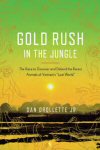SEJournal Online is the digital news magazine of the Society of Environmental Journalists. Learn more about SEJournal Online, including submission, subscription and advertising information.

Book Shelf
Gold Rush in the Jungle: The Race to Discover and Defend the Rarest Animals of Vietnam’s “Lost World”
By Dan Drollette, Jr.
Crown, $25
Reviewed by JENNIFER WEEKS
The concept of biodiversity hotspots — areas home to high numbers of endemic species and under extreme threats — was proposed more than 20 years ago. Some hotspots, such as the island of Madagascar and the reefs of the Coral Triangle in the western Pacific Ocean, are famous.
“Gold Rush in the Jungle,” by SEJ member Dan Drollette, Jr., reveals a lesser-known hotspot: the hills and valleys of Vietnam.
Vietnam’s mountains have been described as a “lost world,” home to rare mammals such as leaf-eating monkeys and barking deer. Ironically, poverty and war helped those species to survive.
Poor roads, long rainy seasons, and rampant tropical diseases kept explorers from penetrating far into Vietnam during the colonial era. During the war decades, from the 1950s to the mid-1970s, parts of the country were devastated by bombs and napalm. But other regions were less affected.
Then diplomatic isolation slowed the country’s economic development.
Now Vietnam is growing quickly, and its exotic fauna are being wiped out almost as soon as they are discovered. Researchers want to find, name and protect new species, but trophy hunters and traders in exotic wildlife want to kill them. The result is a biological gold rush, with scientists and conservationists racing against mercenaries, poachers, warlords and local villagers, who may reap several months’ wages in return for a single rare animal. Many species are used in Asia for traditional medicines: as one example, Chinese three-stripe box turtles (which are believed to cure cancer) can sell for $5,000 per kilogram — more than cocaine or heroin.
The main hero of Drollette’s account is Tilo Nadler, a self-taught biologist from the former East Germany who founded and runs the Endangered Primate Research Center — the first wildlife rescue center in Vietnam. The EPRC protects langurs and other extremely rare animals rescued from captivity or the black market. Drollette uses the EPRC to illustrate the hard work of conservation — learning rare species’ habits and life patterns in detail, creating protected spaces where they can flourish, and in the best cases, releasing some into the wild.
Development threatens Vietnam’s wildlife in many ways. Forests in Vietnam, Laos and Cambodia are being cut to provide material for Vietnam’s furniture export trade. And for wealthy Asians, eating exotic animals is a sign of status. Vietnam is a major trans-shipment point for animal smugglers, who collect rare species such as Asian black bears in poorer countries (Laos, Cambodia, Indonesia) and sell them to customers in China, Taiwan, South Korea and Hong Kong. This pressure isn’t unique to Vietnam, Drollette notes. It’s also likely to play out in other closed societies such as Myanmar and Cuba as they eventually open up to world trade.
The news isn’t all bad. Some rural Vietnamese strongly support local parks and nature preserves, especially if enough eco-tourists visit and spend money for tours and meals. The United States has finally started working with the Vietnamese government to clean up dioxin contamination — a legacy of widespread military use of the defoliant Agent Orange in the 1960s and 1970s.
Every so often, a miracle find occurs. Rafetus swinhoei, a five-foot-long freshwater softshell turtle, was long thought to be on the edge of extinction, except for three males. Then biologists found a female at a zoo in China that could still lay eggs. Now breeding efforts are under way.
As he describes these rare species and the scientists working to keep them alive, Drollette probes many central questions about wildlife conservation. Is it better to save one obscure species, or to try to protect many at once? Why not freeze rare animals’ DNA for cloning in the future instead of spending time and resources keeping a few individuals alive in preserves? What’s lost when a single species goes extinct?
The answers can be surprising. Biologists have searched for decades in some of Vietnam’s most remote areas for a live kouprey — a rare wild ox with large curving horns. Only one has ever been found in a zoo — in Paris in 1937. But scientists are still looking, because the kouprey is believed to be one of the most primitive species of all living cattle. Because it evolved in southeast Asia, it is thought to be immune to many common diseases. Cross-breeding one with domestic cattle could provide a huge immunity boost, potentially worth billions of dollars.
That’s why, even though the last live sighting was in the late 1960s, the search goes on.
Drollette’s narrative is full of surprising insights into modern Vietnam and the world of wildlife conservation. “Gold Rush in the Jungle” shows how hard that mission is, and why we should want it to succeed.
Jennifer Weeks is a Boston-based freelancer and a member of SEJ’s board of directors.
* From the quarterly newsletter SEJournal, Spring 2013. Each new issue of SEJournal is available to members and subscribers only; find subscription information here or learn how to join SEJ. Past issues are archived for the public here.













 Advertisement
Advertisement 



